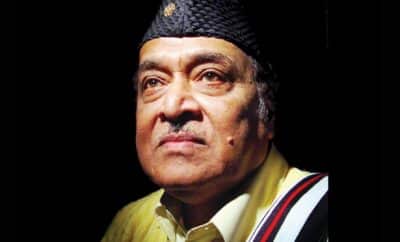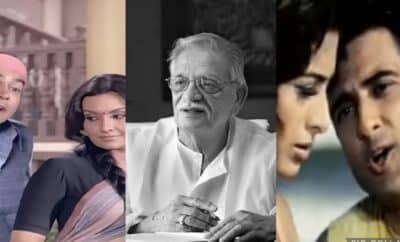Song Sketch
Chaand Aahen Bharega – Phool Bane Angaare – Ode to Bountiful Beauty
When you are in love, you tend to see the loved one everywhere – in the sun, the moon, the mountains, and the river. You hear the loved one’s voice in the whistling of wind and chirping of birds. Everything around you reminds you of that special person. You are literally possessed and do not mind remaining so forever! Imagine that you are on a long drive with your lover, and the radio / music player chooses a song that precisely expresses what you are thinking. Wouldn’t it seem like a divine coincidence? The song “Chaand aahen bahrega” from Phool Bane Angaare (1963) is an exact representation of this situation.
Captain Rajesh (Raj Kumar) is on a drive with his lover Usha (Mala Sinha). He switches on the radio in the car and the beautiful song starts.
Chaand aahen bharega, phool dil thaam lenge,
Husn ki baat chali to sab tera naam lenge…
The moon will start heaving sighs and the flowers will catch their breath after looking at you. Such is your charm! When beauty is being discussed, everyone will name none other than you.
Rajesh points at the radio, looking at Usha, indicating that the song precisely says what he wants to say to her. The fish-eyed, beautiful Usha starts enjoying the song with bashfulness, happiness, and an iota of pride.
The song takes off without much ado, in Mukesh’s voice accompanied by dholak, and makes you tap your feet along, right from the first beat.
After a brief interlude comprising catchy phrases of mandolin and violins, the song advances on the description of the beauty.
Aisa chehra hai tera, jaise roshan savera,
Jis jagah tu nahin hai, us jagah hai andhera,
Kaise phir chain tujh bin, tere badnaam lenge?
Your face is like a bright morning that illuminates the surrounding on arrival. Your absence is darkness. How would those who are defamed for being mad in your love get peace in your absence? Rajesh now gives way to his romantic fantasies and starts seeing Usha in different avatars at fanciful places.
In the second interlude, accordion accompanies violins; and Usha, who is dancing in the clouds of fog in Rajesh’s imagination now moves to the bounties of nature. His description of beauty steps a notch up.
Aankhen nazuk si kaliyaan, baaten misri ki daliyaan,
Hoth ganga ke saahil, zulfen jannat ki galiyaan,
Teri khatir farishte sar pe ilzaam lenge…
To him, her eyes look like delicate buds of flowers. To his ears, her speech seems as sweet as loafs of sugar. He finds her lips as beautiful and pure as the banks of the Ganga, and her hair the lanes of heaven. He thinks that even the angels would be happy to take any blame on themselves for her.
In the third interlude, mandolin takes over again, and thereafter, Rajesh says that her allure is so powerful that even the forces of nature cannot remain unimpacted by it.
Chup na hogi hawa bhi, kuchh kahegi ghataa bhi,
Aur mumkin hai, tera zikr kar de khuda bhi,
Phir to patthar hi shayad zabt se kaam lenge…
Enticed by your elegance, the wind would not be able to remain silent, the clouds will also say something; and what’s more, a possibility cannot be ruled out that even the Almighty will mention you as an epitome of beauty. Only stones would remain unaffected by your gorgeousness.
Though the song expresses the feelings of the hero, it is rather more of the heroine’s song, as she alone is seen in the song for most of the time as the hero’s oneiric beauty.
The most noteworthy part of the song is Anand Bakshi’s wonderful poetry. Starting with clichés like “chaand” and “phool”, he stupendously describes her beauty using unique imagery like “honth ganga ke saahil” and finally connects her beauty with angels and the Almighty. Use of Urdu words adds a grace to the lyrics and makes them different from Anand Bakshi’s usual Hindi-dominated simplistic style. Though he joined hands with the composer duo Kalyanji Anandji less frequently as compared to a few other composers like Laxmikant Payrelal and R.D. Burman, he has written some fantastic songs such as this, whenever he worked with them.
This is one of the euphonious songs in Kalyanji Anandji’s early years. They have decorated the song with melody and orchestration in their unique style to create a perfectly romantic atmosphere.
Last but not the least is Mukesh’s adorable rendition. Think of Mukesh, and what immediately comes to our mind is his unparalleled repertoire of poignant songs. No doubt, he remained the inimitable voice of melancholy for over 3 decades, as due to the inherent deep timbre and the nasal twang, he could paint several shades of pathos effectively. But this very texture of his voice made it suitable also for romantic numbers. Kalyanji Anandji were mindful of this capability and used Mukesh also for several romantic songs like this. He rendered all those songs immortal with his Midas touch.
And coming back to the song, wooing one’s lady in Mukesh’s sonorous voice sounds too sincere and sensuous to be declined by any lady.




Amol
July 23, 2021 at 10:25 pm
5 plus Stars ..The way you have created captured narrated entire song . Simply amazing Yogesh i know how passionate and extra ordinary you are ..
Yogesh Kale
August 1, 2021 at 9:09 pm
Thanks, Amol!